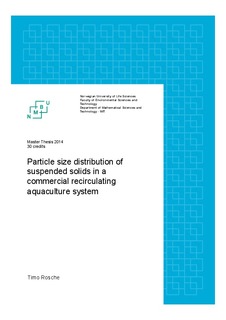| dc.contributor.author | Rosche, Timo | |
| dc.date.accessioned | 2014-09-16T11:28:30Z | |
| dc.date.available | 2014-09-16T11:28:30Z | |
| dc.date.copyright | 2014 | |
| dc.date.issued | 2014-09-16 | |
| dc.identifier.uri | http://hdl.handle.net/11250/219898 | |
| dc.description.abstract | For the understanding of solids characteristic in RAS, the particle size distribution (PSD) of the suspended solids (SS) is a valuable tool. This study evaluates the PSD of the SS in an industrial RAS smolt farm in Norway. Research has been done on the characteristics of the PSD throughout the different water treatment compartments of the RAS as well as the filter efficiency of micro screen drum filter equipped with different mesh sizes.
The laser based PSD analyses using the time-of-transition principle identified strong variations of the volumetric based PSD in the different water treatment units. The fish tank effluent contained particles in the full size range from 5 to >600 µm with strong dominance of particles in the upper size ranges. 55 - 81 % of the particles were bigger than 100 µm. After micro screening, whereby 85 % of the water flow passes 60 µm screens and a side stream of 15 % is filtrated on 30 µm, the PSD shifted towards a high content of fine particles smaller 60 µm (97 %). Downstream from the drum filters the water passes a two-chamber moving bed biofilm reactor (MBBR), in which the PSD changed towards a high content of particles in the range 203 – 300 µm (28 - 66 % of the total particle volume found in this range). This was most probably caused by biofilm release from the moving bed. Downstream the MBBR, the installed degaser (set up as a trickling filter) caused particle breakdown by the induced turbulences. Through the unit the amount of particles in the upper size ranges (>322 µm) decreased by about 50 %. The comparison of PSD previous to pumping to afterwards detected a decrease of particles bigger 256 µm by 68 %, most probably caused by pumping-related particle break down. Still, the samples from the inlet water of the fish tanks carried particles up to 300 µm with about 70 % bigger 100 µm. No evidence for fine particle accumulation in the system could be found. The load of particles smaller 20 µm in the fish tank influent was less than 3 % of the total particle volume.
The filter efficiency test of the installed microscreen drum filter units identified a strong mismatch between PSD and total suspended solid (TSS) based removal efficiencies. Although the PSD results illustrated a highly efficient removal of 97 % of all particles bigger than the filter screen of 60 µm, the TSS based efficiency proved a much smaller weight based TSS reduction of only 34 %. This difference indicates a particle-crushing impact of the drum filter on the particles bigger than the screen size. The particle breakdown caused a higher percentage of smaller particles after the filtration unit. The PSD of the filter effluent from a 10 and a 30 µm microscreen filter also exhibit low filter efficiencies. The PSD of the influent water contained 94 % respectively 87 % of the particles bigger than the filter mesh size. Assuming that the screen hinders all particles exceeding in diameter the mesh size, an equivalent high particle reduction should be expected. In contrast a PSD based removal of only 56 % respectively 48 % of the particles bigger than the filter mesh was found. The high content of particles exceeding in diameter the mesh size of the filter found in the filter effluent could be partly explained by construction failures of the filter screens.
The presented results about suspended solid characteristics and drum filter efficiencies can help to optimize particle removal in modern RAS system. The findings proved a highly dynamic, diversifying PSD affected by the different water treatment compartments. With the attained information about dominating particles sizes, removal strategies can be reviewed to achieve a better particle control and higher removal efficiencies. The optimization of particle removal in RAS is an important milestone for the future development of this innovative fish farming technology. | nb_NO |
| dc.description.sponsorship | Krüger Kaldnes | nb_NO |
| dc.language.iso | eng | nb_NO |
| dc.publisher | Norwegian University of Life Sciences, Ås | |
| dc.subject | Aquaculture | nb_NO |
| dc.subject | RAS | nb_NO |
| dc.subject | Particle size distribution | nb_NO |
| dc.title | Particle size distribution of suspended solids in a commercial recirculating aquaculture system | nb_NO |
| dc.type | Master thesis | nb_NO |
| dc.subject.nsi | VDP::Agriculture and fishery disciplines: 900::Fisheries science: 920::Aquaculture: 922 | nb_NO |
| dc.source.pagenumber | 90 | nb_NO |
| dc.description.localcode | M-AA | nb_NO |
